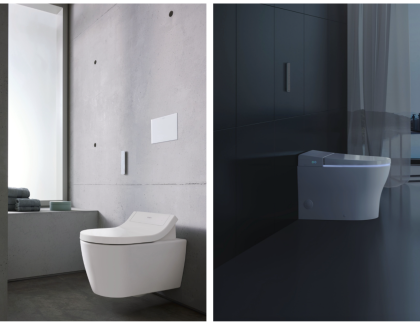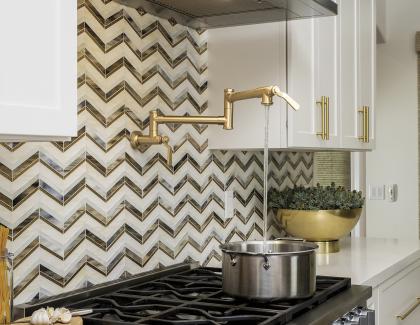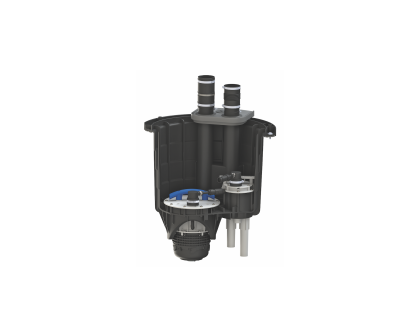Nick Schiffer, founder of NS Builders, gives the low-down on his company’s innovative custom kitchen hood design combines exhaust and make-up air systems in one unit.
Schiffer explains that a major part of creating a quality kitchen hood is making sure that it maintains the air quality in the home when in use. With the custom design, the kitchen hood regulates the air by itself without an inline heater.
[Related: ARE COLORFUL APPLIANCES THE NEXT KITCHEN TREND?]
“Fresh air pours down, hits the front of our cooktop, and it's gonna grab all the steam, the smell, the off-gassing of the burners, and then back up through the exhaust, so it's creating this circular motion and actually makes this more efficient,” Schiffer says. “Now this eliminates the need for an inline heater, so I'm not tempering the air. I'm not dumping freezing cold air in a position where it's gonna make this space uncomfortable…”
Find out more by watching the video.
Transcript:
What's up guys? We're back over at the Lake Drive project, and we are standing in the kitchen. This was a kitchen that we fabricated in-house and did the install. We work with a meal in on the design, but I'm not here to talk about the kitchen just yet because we do have some punch list. I want to talk about something a little bit more technical, which is this hood behind me.
First off, you guys have probably seen the video that Ken did. He ran into a lot of challenges and really worked hard to get this curve shape, and we did it the hard way. So make sure you check out his post on Instagram. We definitely posted a video of it, and he talks a little bit more in-depth about it. I want to talk about the technical side but this hood, not only looks beautiful, but it also functions for two different reasons. It works as our kitchen exhaust, but it also brings in our make up air. Now let me pause and explain a little bit above make up. I'm not an engineer, but I can explain the premise of it. When I turn this kitchen exhaust on, I'm gonna be exhausting upwards of twelve hundred CFM cubic feet permitted in especially new construction homes or newly renovated homes. Homes are usually very airtight. So if I'm exhausting twelve hundred CFM, I'm basically sucking the air out of the house, and the house is trying to replenish that air by usually finding the leaks in the walls, whether it's an open window, cracks in the window, bad door seal, something like that. Well, it's trying to make up the air by doing that, so this make up air that I'm talking about is actually a system that brings in fresh air.
[ Related: 2020 APPLIANCE GUIDE: WHAT YOU SHOULD KNOW PLUS 25 PRODUCTS TO CONSIDER ]
So if I'm exhausting twelve hundred CFM, I'm bringing twelve hundred CFM of fresh air back into the house. Here are a couple of the challenges that you run into when you need to do that. You need to figure out how to bring in freezing cold air because let's assume it's January first: Bring it into the house and temper it. I need to bring it up to a temperature that I'm not going to freeze pipes. If I'm dumping cold air into a basement, or I'm not gonna freeze, my feet if I'm dumping cold air onto it under a toe kick sometimes. I see it dumped into the HVAC system I seen inline heaters, you know the thing with inline heaters. It takes a lot of power to warm up that air before it enters the house. we worked with Roscoe Thule over at T2 engineering as well as Stephan from East Comfort, and built this what we call a hood within a hood. Let me walk you through what we have here: We have a Thermador hood insert. This one has an inline blower. Now a couple things about an inline blower are the inline blower means that this is ducted outside. In this case, it's ran across the garage ceiling. We actually installed that blower in the middle of the ductwork. It helps prevent any excess noise here because the motor is out in the garage. It's actually surrounded by a soffit, but it also makes this insert much smaller rather than having a blower on the top or sometimes two blowers on top of the hood insert. There is nothing on top except for the 10 inch piece of ductwork.
Getting the Fresh Air In
So we actually installed this hood insert and ran that 10-inch piece of ductwork directly out of the house above that. We actually have another piece of 10-inch ductwork coming back in behind this custom hood. That's a lot of ductwork coming in this space, and we knew that we needed to get the second 10-inch ductwork down to the front edge because that second 10-inch ductwork at the very opposite end has a damper. When this hood turns on that damper, and the other end of the second exhaust opens, now what that does is it allows the fresh air to pour through that second piece of ductwork down to here.
We actually made this hood a plenum, so we actually duct sealed the entire inside of this hood. As freezing cold air or warm air or humid air whatever the air might be gets into this hood, its protected, and it's not going to, you know, damage the inside. If this was just raw wood or even painted wood, so this is all duct sealed right now. We don't have this installed, but we're having a custom grill made that will match this Thermador insert. It will be stainless, and it will be removable. and that will allow that fresh air to come down. Now a little bit how that works: Fresh air pours down, hits the front of our cooktop, and it's gonna grab all the steam, the smell, the off-gassing of the burners, and then back up through the exhaust, so it's creating this circular motion and actually makes this more efficient, which is why you and you look at commercial kitchens, they do it this way. Now this eliminates the need for an inline heater, so I'm not tempering the air. I'm not dumping freezing cold air in a position where it's gonna make this space uncomfortable because as soon as it comes in it grabs what it needs, and it's right back out.
[Related: 9 CUTTING-EDGE PRODUCTS THAT EMERGED FROM THE 2020 CONSUMER ELECTRONIC SHOW]
No Simple Task
This was not a simple task. It took a lot of planning and took a lot of layout and just figure out the mechanics and what needed to be done. Then the guys in the cabinet shop can figure out how big the hood needed to be what size insert we could work with, and then the guys in the field, as far as how we were going to actually install this. At this point, we can take down these, and we can assure you reach up inside here, and we'll be able to duct seal that . 10-inch to our
hood insert makes it really nice and easy especially that it has an in-line blower, we're not dealing with a blower that we're working around or having to remove once that's duct sealed. We're basically done. We just need this custom piece, so we'll make sure we get that fabricated. Of course, we'll share that on our Instagram and real quick.
[Related: CHECK OUT THIS HOUSE'S RENOVATION INTO A CUSTOM CABINET PARADISE]
Before we end this video, why don't we pop outside? I'll show you where we're drawing air in and pushing air out. And the reasons as why we chose those locations, so we're on the right side of the home, and we knew we were going to run across that garage, and we knew we needed to be a certain distance apart. But I also wanted to take into consideration comfort ability, you know when people are using this back deck, but also aesthetics when you're looking at the side elevation. So you see between these two windows here on this right side of the garage, that is my exhaust. The reason I chose this location is because it's up out of the way, and it's not in the direct path of where people may be hanging out compared to right behind you up here on this back deck.
This is actually another and this is our fresh air intake so we're not dumping out kitchen exhaust. If you're walking out of the house, you're not hearing this thing roaring. This is strictly just sucking fresh air in and right beyond this wall is our damper and that's that damper I told you that when the kitchen exhaust turns on and it's pumping twelve hundred CFM out this damper opens up and allows fresh air to go in. I hope you guys enjoyed this video. Make sure you guys hit that subscribe button, turn on notifications, so you get notified every week when we come out with a new video. See you guys next time!
[Related: WHAT IS THE DIFFERENCE BETWEEN CUSTOM, SEMI-CUSTOM CABINETS?]







Add new comment